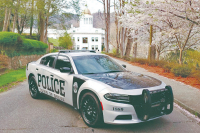Constructing your own coffin
A portion of this Back Then column appeared in SMN in August 2004 as “A Box to Call Your Own.” It has been rewritten and expanded. The notes regarding ancient (pre-Cherokee) burial practices can be found online: www.handsontheland.org/HistoryExploration/cultural_comparison/archives.cfm?cl=death&site=&period=0)
When I was a boy growing up in Virginia, there was a very old man in our neighborhood who was was eccentric; or, at least, his neighbors judged him to be so because he was reputed to have built his own coffin in the work shed behind his house.
His immediate neighbors boasted that they had watched him doing so through the hedges. This made an impression on me. I used to wonder what it would be like to sleep in an open coffin that you had yourself constructed.
Great Britain, for whatever reason, has for centuries specialized in eccentrics of all varieties. Naturally enough, that island nation has produced numerous coffin-building tales. Jemmy Hirst of Rawcliffe was one of Yorkshire’s most eccentric characters during the early 18th century. For one thing, he rode a bull rather than a horse when foxhunting. For another, he made a vehicle equipped with sails and a carriage of wicker-work that housed his bed and was drawn by Andalusian mules.
Jemmy, of course, constructed his own coffin. It had windows and shelves. When he died in 1829, aged 91, 12 pounds from his estate was set aside to pay a dozen old maids to follow his coffin to the burying ground. Two musicians were also engaged, a fiddler and a piper, who, as a final salute, played Jemmy’s favorite tune “O’er the Hills and Far Away,” which I also like and have placed on my tentative song list.
This country has turned out its fair share of “original characters” — as eccentrics were known in the 19th century. One day a man named Warren Snow, who Moffit didn’t care for, entered his place of business. Seeing the coffin hanging over the checkout counter, Snow dared to inquire as why it had been made so far in advance of his likely death. Moffit looked up and replied: “I want everything dry and light so I can go over Hell just a-flying, so I won’t have to stop down and see you.” All of us could do worse than be “light and dry” so we can “go over hell just a-flying” when the time comes.
Related Items
Closer to home, Sylva native John Parris noted in These Storied Mountains (1972) that “Many a mountain man has made his own coffin. But old man Eddie Conner is the only man I ever heard of who planted the tree that provided the lumber for the one they laid him away in.”
In May 1885, Conner had as a young man planted a walnut sprout at his sister’s home place in the Smokemont area of what is now the Great Smoky Mountains National Park. In 1918 he suffered “a slight stroke of paralysis” and decided it was high time to get “busy making my preparations for the last go-round.” By this date, the walnut sprout had grown into a tree that measured two feet and seven inches in diameter.
With the help of two Cherokee Indian men, Conner felled the tree and they drug it to a nearby rail line, where it was loaded up and freighted “to the big band sawmill at Ravensford where the lumber was cut for my casket.” A carpenter by the name of Jim Ayers assisted Conner in the construction of his casket.
This wasn’t your ordinary run of the mill casket. It featured “a heavy walnut panel on the lid to make a round or oval-shaped top.” It was “trimmed in three-inch cherry molding, cut in mitered squares like picture frames, leaving a two-inch black walnut margin clear around the top, the sides and the ends.” The brown and red colors highlighted the casket’s appearance so much that, in Conner’s eyes, it “truly gives a beautiful combination beyond compare.” And to top it all off, the lid was constructed from “two pieces, joined together with hinges near the bulk of the breast, with a face glass reaching almost back to the joint hinges, well counter-sunk, to prevent the heavy lid from smashing it.”
When it was done, Conner gave his creation a test drive, as it were, by putting in his pillow and laying down in it “to see how good it fit.”
The coffin was then stored away in the attic of Coot Hyatt’s home above Bryson City. Upon passing away in 1951 at the age of 87 — 33 years after finishing it — Eddie Conner was laid to rest in his masterpiece.
During the prehistoric Archaic Period, 10,000 to 3,000 Years Before Present, people usually buried their dead in shallow graves in a flexed or semi-flexed position. These were sometimes lined with stone. In regions where bedded limestone occurred stone box graves were constructed for both elite and commoner. Burial items for a 16-20 year old high-status female in the summit of a mound included a short neck painted water bottle, marine shell beads, and turtle shell rattles on each ankle. Accompanying a child in a separate burial “were two marine shell ear pins and copper beads” as well as “preserved fragments of cordage and red and yellow textile.”
A person I know claims there are “no dogs in heaven.” We used to argue about this over the Internet. To my way of thinking, heaven wouldn’t be heaven without dogs. The early Indians and then the Cherokees apparently felt the same way as a favorite dog was sometimes buried with his master so they could make the journey into The Darkening Land together.
George Ellison wrote the biographical introductions for the reissues of two Appalachian classics: Horace Kephart’s Our Southern Highlanders and James Mooney’s History, Myths, and Sacred Formulas of the Cherokees. In June 2005, a selection of his Back Then columns was published by The History Press in Charleston as Mountain Passages: Natural and Cultural History of Western North Carolina and the Great Smoky Mountains. Readers can contact him at P.O. Box 1262, Bryson City, N.C., 28713, or at This email address is being protected from spambots. You need JavaScript enabled to view it..









